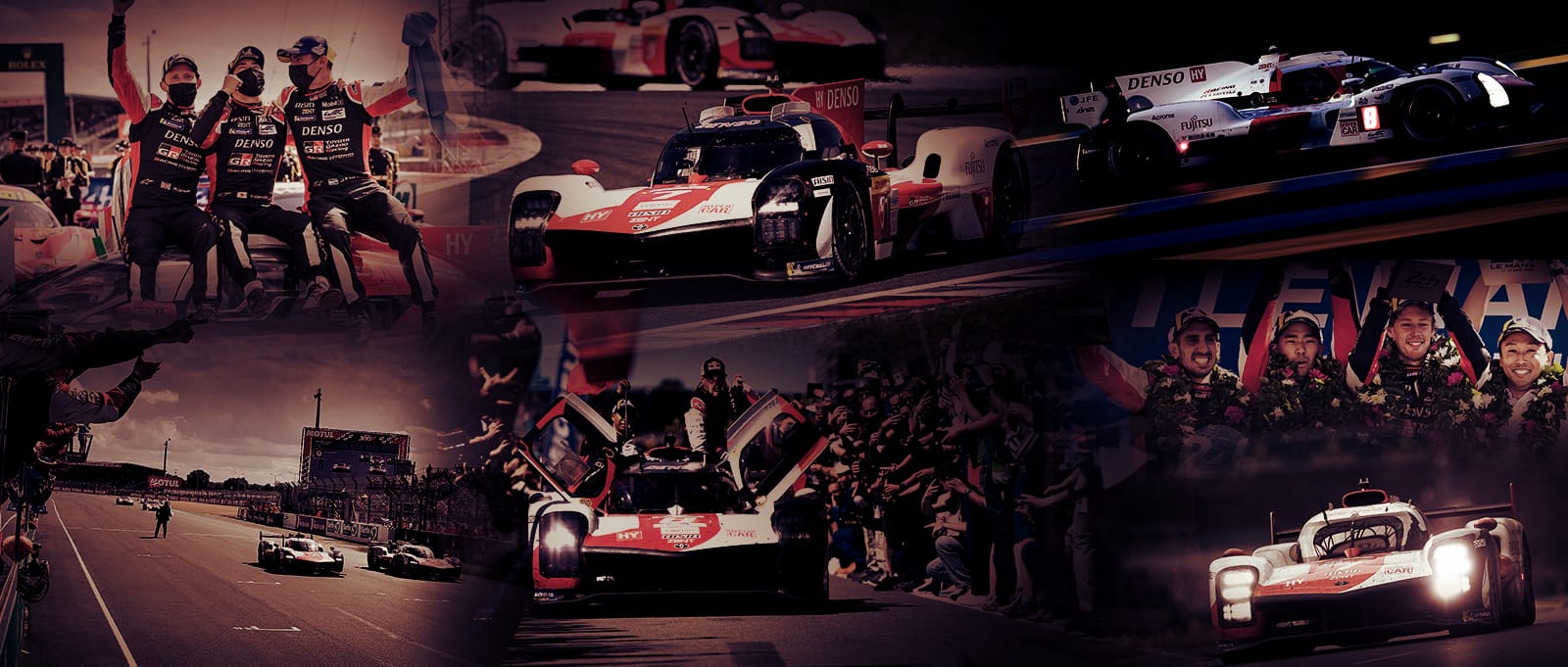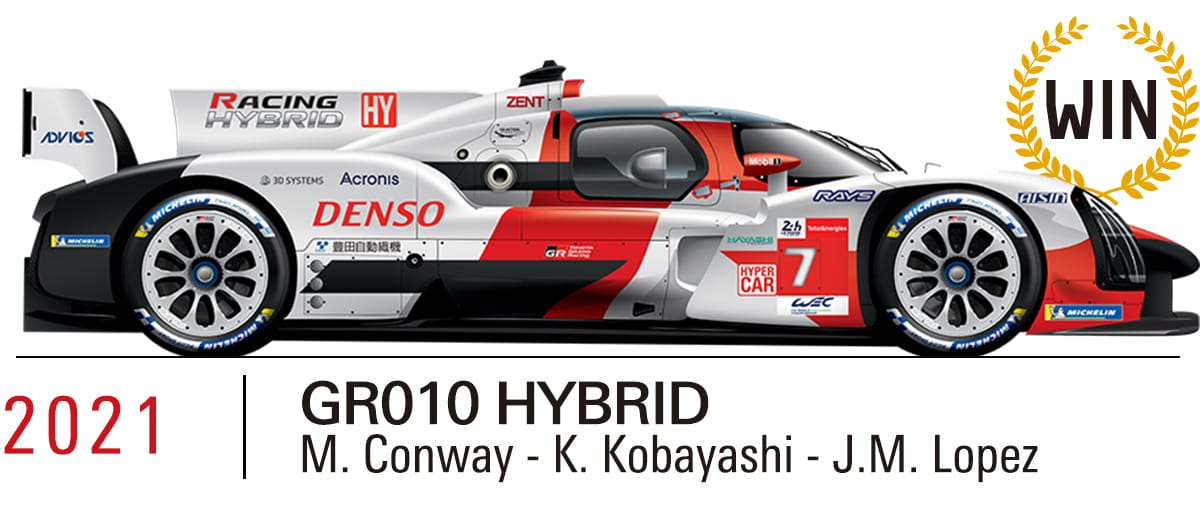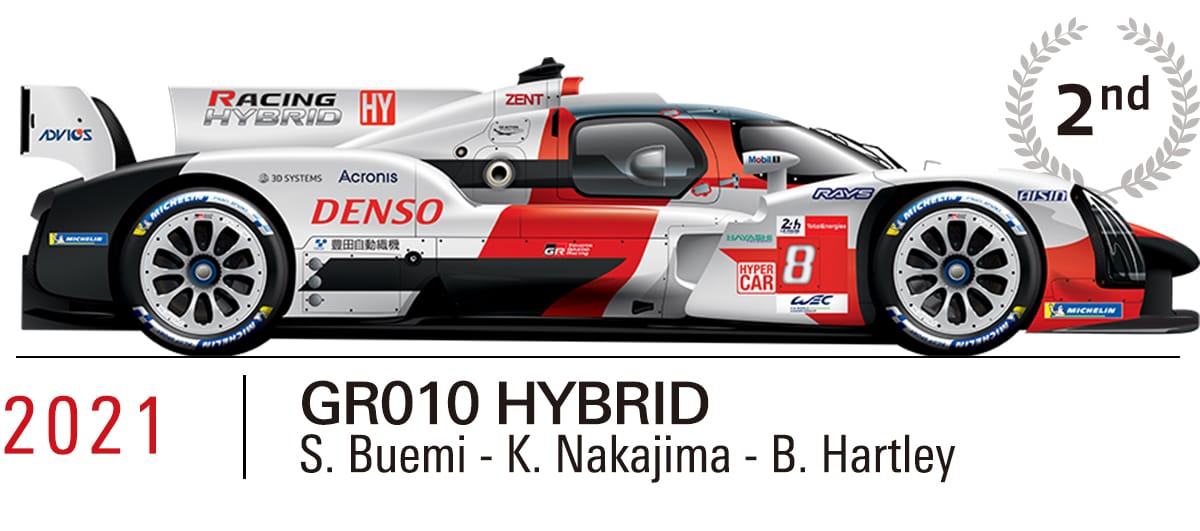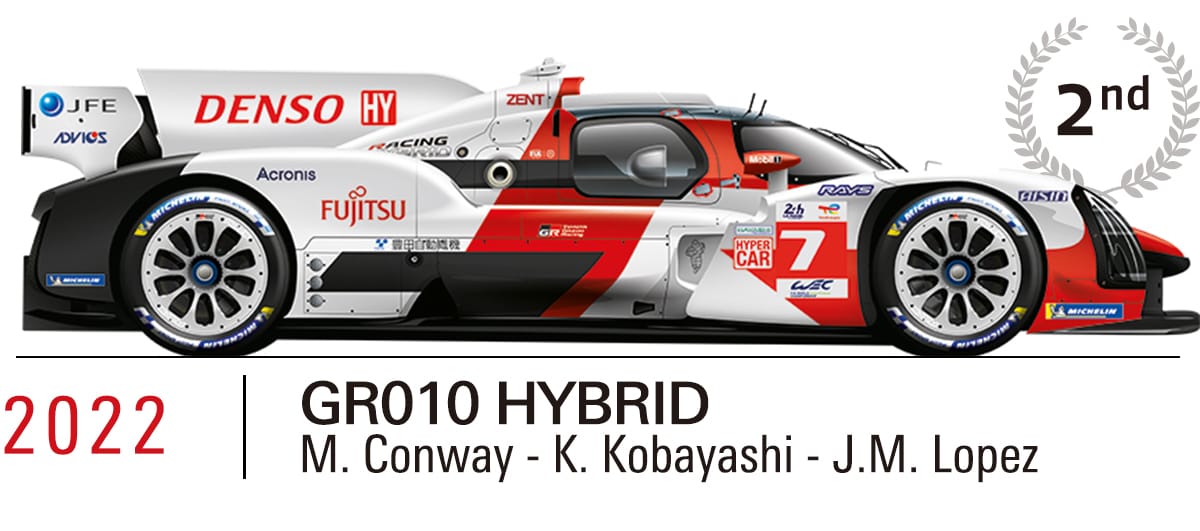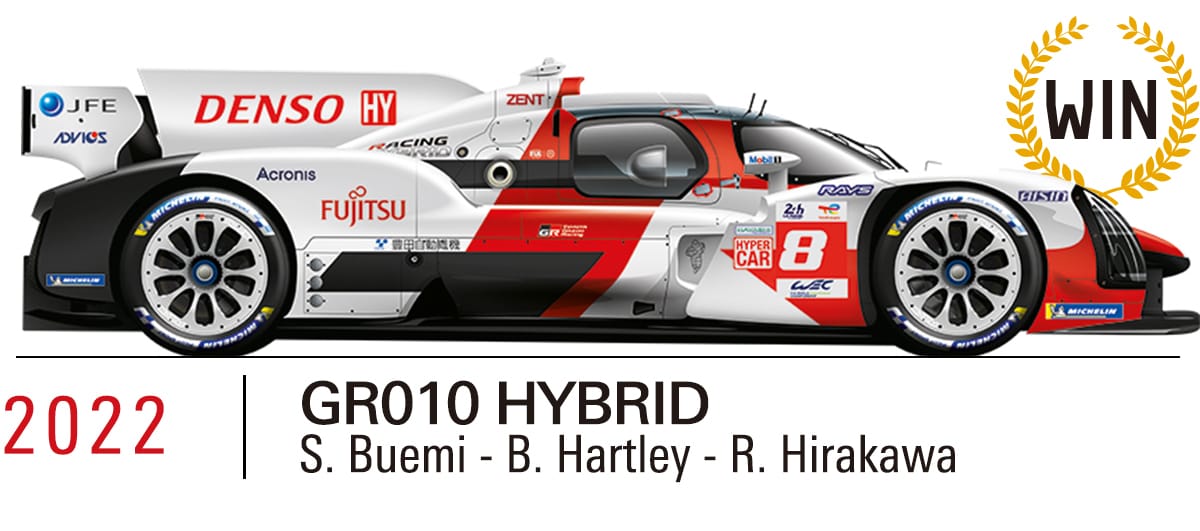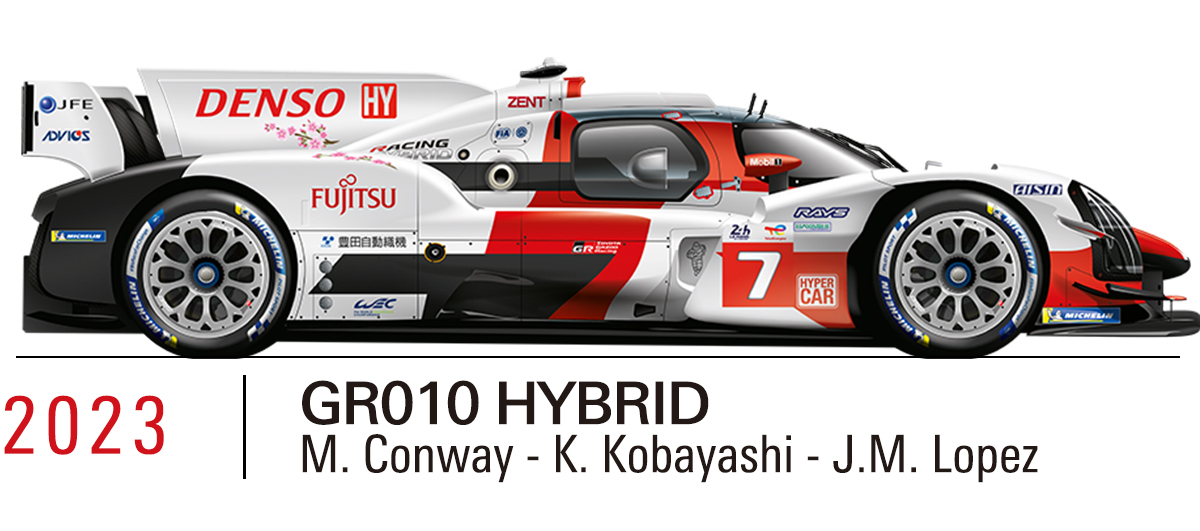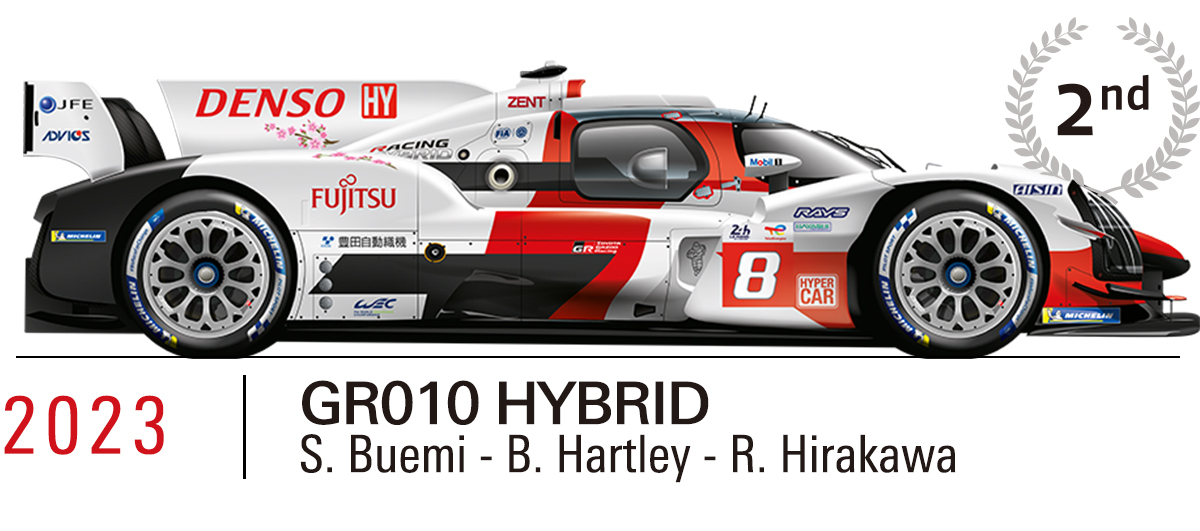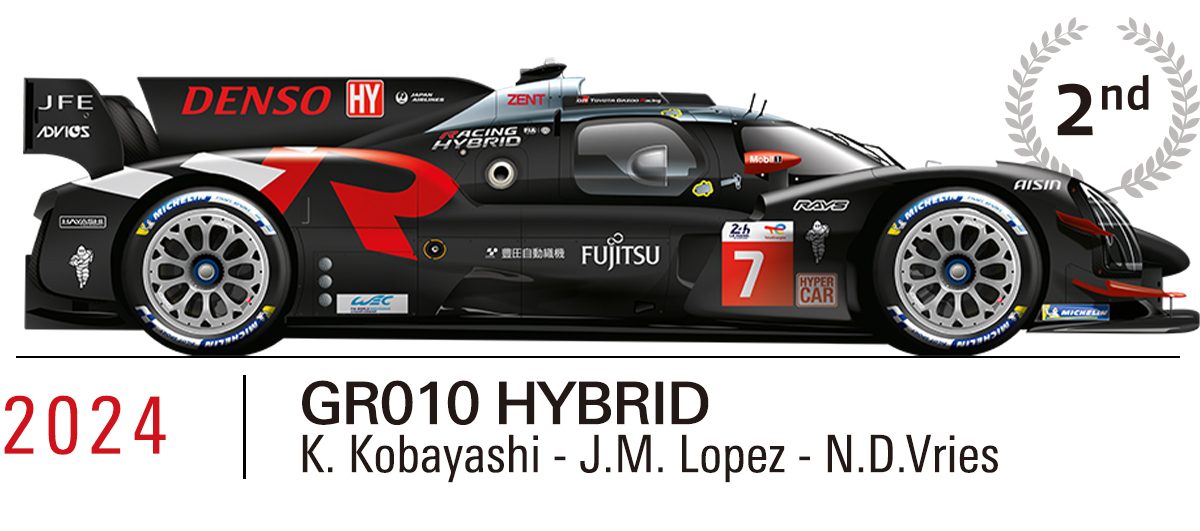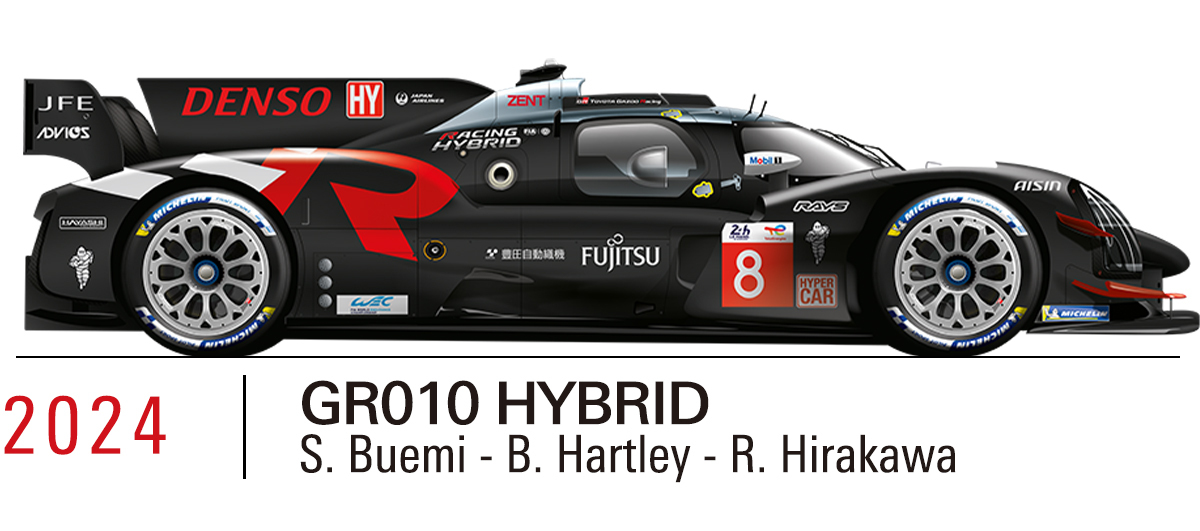The History of TOYOTA at Le Mans
Looking back over a long history of unending challenges
2021-2024
Victories continued in the new Hypercar era to give TGR a 5th straight title in 2022!
Disappointing 2nd-place finishes followed in the 100th anniversary year 2023 and 2024.
The 2021 season marked the start of a new era with the change in the pinnacle class from the LMP1 (Le Mans Prototype1) to the Hypercar. The GR010 HYBRID car No. 7 driven by Kamui Kobayashi took the first Pole Position of this new era and the fifth in a row for the Toyota at Le Mans.
Meanwhile, car No. 8 with drivers Sébastien Buemi, Kazuki Nakajima and Brendon Hartley, was hit by another car and spun out just after the start. After recovering from that, No. 8 moved back up to join the leaders. There it would compete for the lead with car No. 7 until trouble developed in the car’s fuel system. However, the team did not return the car to its pit garage, but instead proposed another solution. With it, the driver was able to overcome the trouble by employing some special setting changes while on the run.
After that, car No. 7 suffered the same trouble that had occurred in car No. 8 but was able to overcome it by using the same setting solution that had worked for No. 8. With this, No. 7, now driven by the final driver, Kamui Kobayashi, was able to run on in the lead all the way to the checkered flag, while holding off Kazuki Nakajima running in 2nd position in car No. 8. For Kobayashi, it was his long-awaited first overall win, and for TGR it was a great accomplishment, not only in winning its fourth consecutive win at Le Mans but also the first title of the new Hypercar class era.
In 2022, the 90th anniversary of the Le Mans race, open vehicle inspections were held at Republic Square for the public to see for the first time in three years, showing that Le Mans had returned to normal.
Toyota Gazoo Racing (TGR), in its second year competing in the Hypercar class, will enter the 24 Hours of Le Mans with Mike Conway, Kamui Kobayashi and José María López driving the No. 7 car and Sébastien Buemi, Brendon Hartley and Ryo Hirakawa driving the No. 8 car. In the qualifying, Kobayashi in car No. 7 took provisional pole position, and in the Hyperpole, Hartley in car No. 8 took pole position for the TGR team for the sixth consecutive year with an amazing show of speed. Car No. 7 also took second place to give the TGR team both spots on the front row.
The final was held in fine weather. Car No. 7 took the front spot in a 1-2 lead with car No. 8, and the two continued to battle on with the top spot changing hands at times. Car No. 8 took the lead before the half-way point of the race. But later, car No. 7 regained the lead, and then car No. 8 suffered a tire puncture, which widening the gap between the two cars. However, before 8 a.m., car No. 7 had to restart its hybrid system due to electrical problems, and to do so, the car was brought to a stop at trackside. With this, car No. 8 took the lead again. Then car No. 7 suffered a slow puncture but was still able to maintain the team’s 1-2 lead. With 30 minutes to go, López set the fastest lap of the race. Together with the No. 8 car in the lead, they continued run strongly until the finish. Hartley, driving the No. 8 car that had started the race from pole position, was the first to take the checkered flag and the win, with car No. 7 also coming home on the same lap for a 1-2 finish. With this, TGR won the Hypercar class for the second year in a row, and as a team for the fifth consecutive year since their first Le Mans victory in 2018.
The year 2023 marked the 100th running of the 24 Hours of Le Mans. A huge number of some 325,000 spectators turned out to watch the race. Owing to the fact that LMDh specification cars could run in the pinnacle Hypercar class, works machines by makers including Porsche, Ferrari, Peugeot and also Cadillac entered the race. The number of cars competing from all the classes totaled 62. As with the year before TGR entered its GR010 HYBRID car No. 7 driven by Mike Conway, Kamui Kobayashi and José María López, and car No. 8 driven by Sébastien Buemi, Brendon Hartley and Ryo Hirakawa with the aim of winning for 6th consecutive time.
However, before the test day, the minimum weight regulation for the Hypercar class was revised and the GR010 HYBRID was given the largest increase in the class of 37 kg. Despite this, the two GR010 HYBRID cars were quickly able to make necessary adjustments to enter the two cars in the HyperPole. But despite the all-out effort of Hartley in the time attacks, car No. 8 was held to 3rd position by a small margin. Due to a track limit violation by Kobayashi in car No. 7 that disqualified its best time, it failed to take a seventh consecutive pole position by finishing in 5th place.
In the early stages of the race, there were troubles caused by accidents and sudden changes in the weather. As for the two GR010 HYBRID cars, No. 8 took the lead in the first lap and No. 7 was also in reach of a podium finish, and after that they both continued to remain in contention for the win.
But eight hours after the start, luck ran out for car No. 7 while it was chasing the leading car No. 8. Two cars collided with it as No. 7 was entering a slow zone. Kobayashi tried to restart after that but the damage to his car was too severe and he had to retire from the race.
Meanwhile, No. 8 was involved in a fierce fight for the lead with the No. 51 Ferrari. A close battle between the two continued into the final stages of the race, and in the end car No. 8 driven by Buemi, Brendon Hartley and Ryo Hirakawa finished in 2nd place. With this, they were unable to take a sixth consecutive win. Third place went to Cadillac, which meant that the winners platform was shared by cars from Europe, Japan and the U.S.
In 2024, TGR aimed for its sixth overall Le Mans win. With Mike Conway, Kamui Kobayashi and Nyck de Vries driving the GR010 HYBRID No. 7 car and with the No. 8 car driven by Sébastien Buemi, Brendon Hartley and Ryo Hirakawa. Five of these six drivers had previously experienced overall wins, while Kobayashi was current holder of the course record, making for a formidable lineup of drivers. However, just prior to the race, Conway suffered injuries in a bicycle accident and José María López was brought in to replace him.
On test day, Kobayashi in car No. 7 recorded the top time in the first session. Following the qualifying, car No. 8 showed its speed by taking the top times in the FP1 and FP2. However, in the qualifying, Kobayashi in car No. 7 ran the 4th fastest time only to have it disqualified due to a penalty. Meanwhile, Hartley in car No. 8 finished in 11th position due to traffic, meaning that neither car could move on to the Hyperpole.
In the final race, car No. 8 pushed hard toward the front and managed to join in the fight for 3rd place at the end of the first hour, after which car No. 7 managed to join the top six by the end of the fourth hour. As the rain that had begun to fall grew stronger in the middle stages of the race, car No. 8 was engaged in a battle for the lead with the No. 83 Ferrari, with the lead changing hands between the two time and again. As car No. 7 ran on in 5th position, it was given a drive-through penalty at the end of the fifth hour, causing it to lose ground. However, as the race passed the 12 hour point, it continued to be a close contest, with the top 11 cars all running within the span of one lap. Among them, car No. 8 was now holding the lead and No. 7 had also moved up to 3rd position.
After that, car No. 8 continued to run strongly in the lead, but with two hours remaining in the race, it was hit by the No. 51 Ferrari and spun out. Although this caused No. 8 to lose ground, it still managed to move up again and finish the race in 5th place.
Meanwhile, car No. 7 suffered two tire punctures that caused it to fall back, but in the final stages of the race, López recover ground and managed to climb back to 2nd position and engage in a fierce battle with the leading No. 50 Ferrari. Finally, he ended up finishing the race in 2nd place by a margin of just 14.221 seconds.
